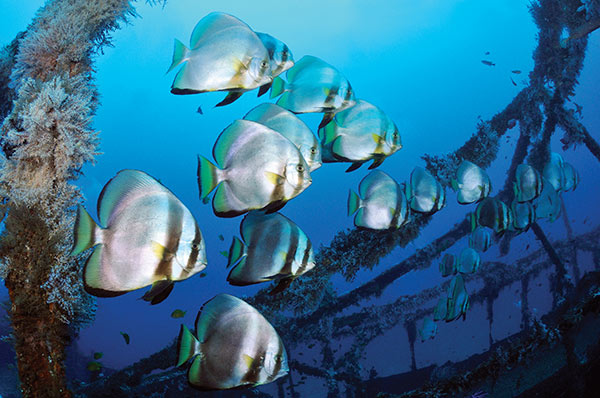The Metaphor of the Swiss Army Knife

By Michel Gilbert & Danielle Alary
We use a Swiss Army knife on ALL assignments. First, the plastic toothpick of this old companion is the best O-ring removal tool ever made. Second, other components such as the screwdrivers, scissors or tweezers always come in handy.
As Michel was unscrewing a sync port cap with his Swiss companion, it occurred to him that it is not possible to simultaneously use two built-in tools of this knife. It forces you to concentrate on one thing and one thing only.
A good lesson
When you think about it, the same applies to u/w photography: it is impossible to produce good results if you try to do everything during the same dive – macro, wide-angle, fish portrait, seascape, super-macro…. You may combine macro and fish portrait, but adding wide-angle becomes a recipe for disaster.
Some housing manufacturers let you carry wide-angle conversion lenses that mount on the normal macro/fish portrait optics and all sorts of fancy accessories. Their ads make you think you may snap a picture of clownfish eggs and then, within 30 seconds, switch a wide-angle adapter and photograph the great hammerhead that was looking over your shoulders.
As exciting as this proposition appears, it cannot lend good results for one main reason: brain connections.
When you drive a car forward and want to switch in reverse gear you must stop, engage the reverse and then carefully look in your mirrors, turn your head and slowly accelerate. This cannot be done in a nanosecond and it implies a whole new way of looking and anticipating what can happen.
Think about your photography. If you are concentrated on a macro subject, your universe shrinks to the size of a post stamp. Your aperture, shutter speed, strobe position, buoyancy and what-not are all geared toward making the picture you have in your mind.
This is just like having your Swiss Army Knife screwdriver pulled out.
Now imagine that a wide-angle subject swims by and that you see it coming. How long will it take before you readjust your aperture, shutter speed, strobe position and buoyancy to be ready to capture the scenery? And this is the easy part. The most difficult aspect of the exercise is to switch your brain from macro to wide-angle mode. Unless you are a working pro, your brain can hardly make the switch and allow you to take quality pictures in an instant.
Like the Swiss Army Knife, you need to change tool – mental tool – to accomplish the mission and that may be harder than you think.
Of course, if you are satisfied with a blurry silhouette of the swimming shark that’s OK. Making a picture that will tell a story becomes an almost impossible task.

The other problem
Let’s assume that you are able to switch gear and brain; the problem then comes from the amount of images you are able to make of a single or a specific type of subject.
The best pros in the business take tens of images of the same fish species. A casual shooter cannot achieve similar results if he devotes one or two frames to a given subject.
Granted, you may not be trying to sell to Smithsonian or BBC Wildlife magazine. However, you probably aim to produce great looking images and this comes with practice, patience and many frames spent on the same creature.
Life is about choices
In underwater photography, we must make hard choices – including concentrating on a specific type of photography during a dive.
It means that you make your choice while at the surface: preparing yourself, listening to the divemaster’s briefing, talking with other experienced divers who may suggest different subjects.
Visualizing your potential subjects in advance and thinking about settings helps produce better results.
Some photographers will enter the water with two cameras, a macro/fish portrait lens and a wide-angle one. In this case, they must be fast thinkers and have an assistant ready to hand one of the two cameras. But, even then, the photographer must switch his or her brain very fast and cannot go from one type of image to another constantly.
If you dive with another photographer, then complement each other by using different lenses. Once you are done with a subject, ask your buddy to come by and make a different type of image. This is exactly how we work. We never have the same lenses and we make sure that if a subject is worth shooting with two different perspectives we accomplish it before surfacing.
The best tool
Our precious Swiss Army Knife is part of every trip and it reminds us to concentrate and do one thing at a time. Buy one. It’s worth the price!
Leave a Comment







